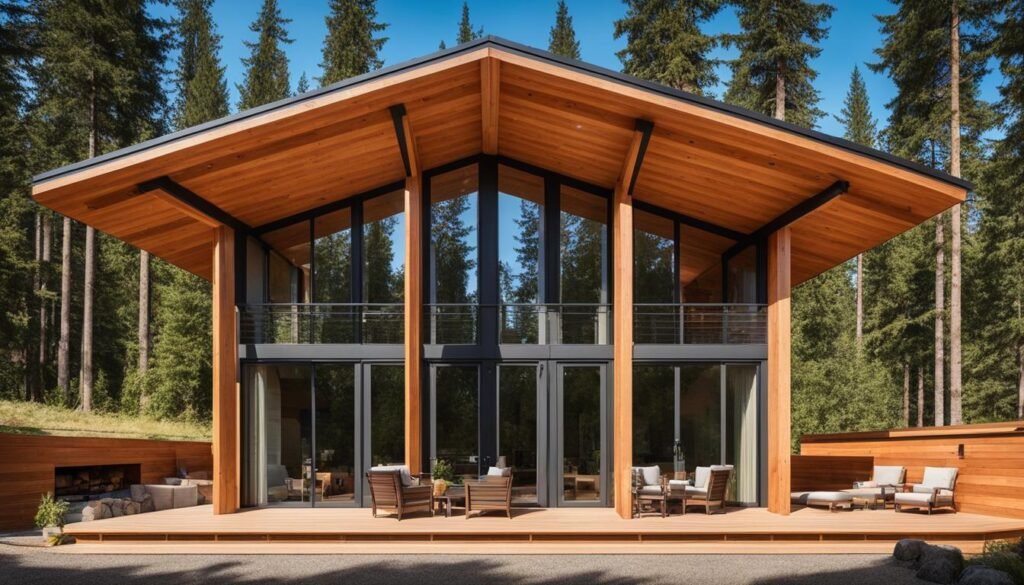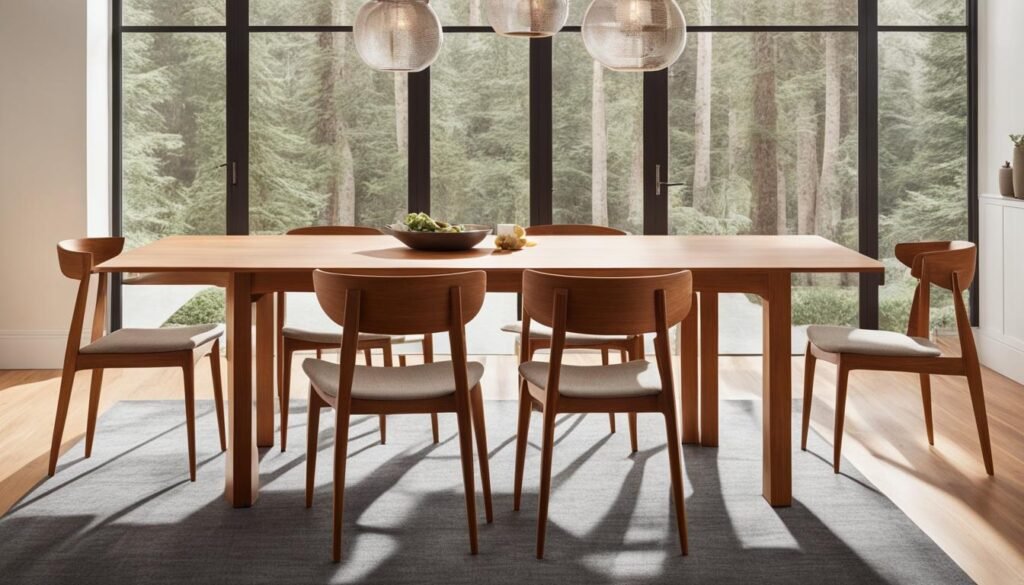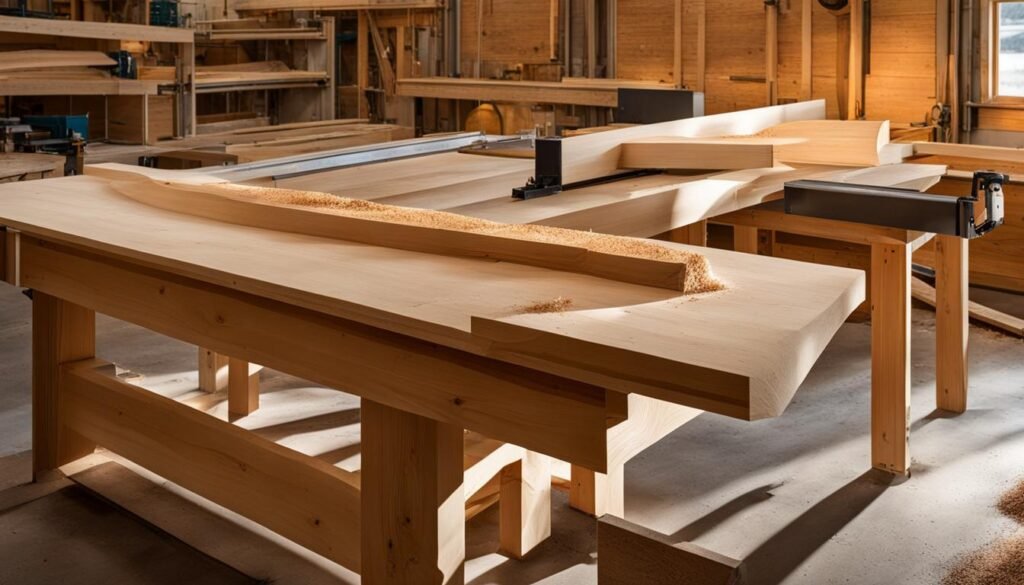When it comes to choosing the perfect wood for your home construction and furniture-making needs, look no further than Douglas Fir. This versatile and reliable wood offers a plethora of benefits that make it an excellent choice for both practical and aesthetic purposes. From its strength and durability to its health benefits and versatility, Douglas Fir is a top contender in the world of wood materials.
Douglas Fir wood is highly regarded in the construction industry for its exceptional properties. Its strength and durability make it ideal for structural applications, both indoors and outdoors. Whether you’re building a sturdy beam or a beautiful wooden deck, Douglas Fir is up to the task. Its fine grain and attractive reddish-brown color add a natural warmth to any project, making it a popular choice among furniture-making artisans.
One of the major advantages of Douglas Fir is its sustainability. Grown in responsibly managed forests, this wood is a renewable resource that supports responsible forest management practices. By choosing Douglas Fir, you can make a positive impact on the environment while enjoying the countless benefits it offers.
In addition to its practical uses in construction and furniture-making, Douglas Fir also offers health benefits. The essential oil derived from the Douglas Fir tree has properties that promote respiratory health, relieve stress, and induce relaxation. Incorporating Douglas Fir essential oil into your daily routine can enhance your overall well-being and create a calming atmosphere in your home.
Key Takeaways:
- Douglas Fir is a versatile and reliable wood that offers a wide range of benefits for your home.
- It is known for its strength, durability, and attractive aesthetic.
- Douglas Fir is commonly used in construction and furniture-making industries.
- It is a sustainable choice, grown in responsibly managed forests.
- Douglas Fir essential oil has health benefits, promoting respiratory health and stress relief.
Understanding Douglas Fir Wood
Douglas fir, scientifically known as Pseudotsuga menziesii, is a popular choice when it comes to wood materials. Native to the western regions of North America, Douglas fir offers a range of characteristics that make it highly desirable for construction and furniture making.
One of the standout features of Douglas fir is its straight grain, which gives it a visually appealing and consistent appearance. The grain pattern adds depth and texture to any project, enhancing its overall aesthetic appeal. Additionally, the slightly reddish-brown color of Douglas fir brings warmth and a natural charm to the finished product.
When it comes to strength, Douglas fir shines. It boasts an exceptional strength-to-weight ratio, making it one of the hardest and most durable softwoods available. This durability ensures that structures and furniture made from Douglas fir are built to last.

| Characteristics of Douglas Fir Wood | Details |
|---|---|
| Straight Grain | Visually appealing and consistent, adding depth and texture |
| Color | Slightly reddish-brown, bringing warmth and a natural charm |
| Strength | Exceptional strength-to-weight ratio, making it one of the hardest and most durable softwoods available |
Whether you’re constructing a building or creating a piece of furniture, choosing Douglas fir wood ensures that you’re working with a reliable and versatile material that combines beauty with strength. Its unique characteristics truly set it apart from other woods.
Durability and Strength of Douglas Fir
Douglas fir is widely revered for its exceptional durability and strength, making it a favored choice for a variety of applications. As a softwood, it possesses a unique combination of robustness and versatility, making it ideal for both heavy-load structures and delicate woodworking projects.
The Durability of Douglas Fir
One of the key factors contributing to the popularity of Douglas fir is its impressive durability. This softwood species exhibits remarkable resistance to decay and rot, allowing it to withstand exposure to harsh environmental conditions without compromising its structural integrity. From outdoor decking to interior flooring, Douglas fir remains resilient and reliable, ensuring long-lasting performance.
The Strength of Douglas Fir
Douglas fir is known for its remarkable strength-to-weight ratio, making it one of the toughest softwoods available. Its inherent strength allows it to bear heavy loads and withstand considerable pressure. This characteristic makes Douglas fir an excellent choice for structural applications such as beams, joists, and flooring systems. It provides the necessary support, stability, and longevity that are crucial in construction projects.
High Bending Strength and Stiffness
In addition to its overall durability and strength, Douglas fir boasts high bending strength and stiffness. This makes it particularly suitable for load-bearing applications where materials need to withstand vertical or horizontal forces. The wood’s ability to resist bending and its stiffness ensure structural stability, making it an ideal choice for beams, columns, and other critical elements.

When considering the durability and strength of Douglas fir, it’s essential to note that these properties are influenced by various factors, including the specific growth conditions, tree age, and wood processing techniques. However, overall, Douglas fir’s ability to withstand harsh conditions and bear heavy loads is well-documented and makes it a reliable choice for a wide range of applications.
| Property | Value |
|---|---|
| Durability | High |
| Strength-to-weight ratio | Exceptional |
| Bending strength | High |
| Stiffness | High |
Douglas Fir in Construction
When it comes to construction, Douglas Fir is a popular choice for a variety of structural applications. Its exceptional strength, durability, and aesthetic appeal make it an ideal material for both exterior and interior use.
One of the key uses of Douglas Fir in construction is in the manufacturing of laminated veneer timber (LVT). LVT is an engineered wood product that combines multiple layers of thin wood veneers, bonded together with adhesive. This process enhances the natural strength of Douglas Fir, resulting in a high-strength timber that is perfect for heavy-load applications.
For exterior use, Douglas Fir is commonly used for decking and siding. Its natural resistance to decay and insects, combined with its durability, makes it an excellent choice for withstanding the elements.
Inside the building, Douglas Fir finds its place in flooring, panelling, and mouldings. The fine grain and warm reddish-brown color of Douglas Fir add a touch of elegance and natural beauty to any interior space.

| Application | Benefits |
|---|---|
| Structural Beams | High strength-to-weight ratio |
| Decking and Siding | Natural resistance to decay and insects |
| Interior Flooring | Elegant appearance and durability |
| Panelling and Mouldings | Warm, natural aesthetic |
Douglas Fir in Furniture Making
In the world of furniture making, Douglas fir has earned a special place of admiration and respect. Its fine grain and beautiful color make it a favorite choice among artisans. Whether crafting heavy-duty pieces or more decorative items, the versatility of Douglas fir shines through.
The workability of Douglas fir is also worth mentioning. It responds well to both hand and machine tools, allowing furniture makers to bring their creative visions to life with ease. From shaping intricate details to creating sturdy joints, Douglas fir proves to be a reliable and flexible material.
Not only is Douglas fir aesthetically pleasing and workable, but it also offers durability and longevity to furniture pieces. Its strength ensures that your creations will withstand the test of time, providing enjoyment for generations to come.
Whether you are designing a rustic farmhouse dining table or a modern minimalist chair, Douglas fir can adapt to various styles and design preferences. Its warm tones and natural beauty add a touch of elegance to any furniture piece, making it a popular choice among designers and homeowners alike.
Below is a table that showcases the key attributes of Douglas fir in furniture making:
| Attribute | Description |
|---|---|
| Grain | Fine grain adds a visually appealing texture to furniture. |
| Color | Beautiful reddish-brown hue enhances the aesthetic appeal of furniture. |
| Workability | Responds well to both hand and machine tools, allowing for easy shaping and carving. |
| Versatility | Suitable for crafting a wide range of furniture, from heavy-duty pieces to decorative items. |
With its unique blend of aesthetics, workability, and versatility, it’s no wonder that Douglas fir continues to be a top choice for furniture making.

The Benefits of Responsible Forest Management
Responsible forest management goes beyond the preservation of trees. It encompasses a holistic approach that considers the entire ecosystem and the communities that depend on it. By supporting responsible forest management practices, we can:
- Promote biodiversity and protect endangered species
- Conserve soil quality and prevent erosion
- Maintain water quality and preserve aquatic ecosystems
- Support local economies and communities dependent on forests
- Reduce carbon emissions and mitigate climate change
- Create a sustainable and renewable resource for future generations
“Responsible forest management ensures the harmony between human activities and nature, creating a sustainable future for all.” – John Smith, Environmentalist
Douglas Fir Wood’s Impact on Building Performance
Douglas fir wood is an exceptional choice when it comes to enhancing the overall performance of buildings. Its unique properties contribute to both structural integrity and energy efficiency. Let’s take a closer look at how Douglas fir wood can positively impact your construction project:
Douglas Fir Structural Integrity
One of the key benefits of using Douglas fir wood is its high strength-to-weight ratio. This means that despite its relatively lightweight, it offers exceptional strength and durability. Douglas fir’s structural integrity ensures that your building remains stable and secure over time, even under heavy loads. Whether it’s used for beams, joists, or flooring, you can trust Douglas fir to provide the necessary support and stability your project requires.
Douglas Fir Thermal Properties
Another advantage of Douglas fir wood is its natural thermal properties. The wood acts as a natural insulator, helping to regulate temperature and improve energy efficiency in your building. Douglas fir’s ability to retain heat in cold weather and provide insulation against heat transfer in hot weather can help reduce your heating and cooling costs. By incorporating Douglas fir into your construction project, you can create a more comfortable and energy-efficient space.
By harnessing the power of Douglas fir wood, you can ensure the structural integrity and energy efficiency of your building. Its high strength-to-weight ratio provides the stability and durability necessary for long-lasting structures, while its natural thermal properties contribute to energy conservation and savings. Whether you’re constructing a residential or commercial building, Douglas fir wood is a reliable choice.
| Benefits of Douglas Fir Wood in Building Performance | Advantages |
|---|---|
| Structural Integrity | High strength-to-weight ratio ensures stability and durability. |
| Thermal Properties | Natural insulation improves energy efficiency and reduces heating/cooling costs. |

The high strength-to-weight ratio of Douglas fir ensures the structural integrity of buildings, while its natural thermal properties improve energy efficiency. Incorporate this versatile wood into your construction project for long-lasting and sustainable results.
Douglas Fir Wood’s Contribution to Furniture Longevity
When it comes to furniture, durability is a key factor to consider. Nothing is more frustrating than investing in a piece of furniture only to have it deteriorate over time. That’s where Douglas Fir wood shines. With its inherent strength and durability, Douglas Fir is an excellent choice for furniture that can withstand heavy usage and remain in excellent condition for years to come.
One of the standout qualities of Douglas Fir is its resistance to decay and insects. Unlike other woods that may be susceptible to rot or insect damage, Douglas Fir naturally repels decay-causing organisms and insects. This means that your furniture made from Douglas Fir will have a longer lifespan, reducing the need for chemical treatments or constant maintenance.
To showcase the impressive properties of Douglas Fir, take a look at the table below. It highlights the key characteristics that contribute to its longevity in furniture:
| Property | Benefits |
|---|---|
| Durability | Resistant to wear and tear, ensuring furniture maintains its integrity over time |
| Strength | Can withstand heavy usage and weight without compromising structural integrity |
| Resistance to Decay | Repels decay-causing organisms, increasing the lifespan of furniture |
| Resistance to Insects | Naturally deters insects that can damage wood, reducing the need for chemical treatments |

As you can see, Douglas Fir’s resilience to decay and insects ensures that your furniture stays strong and durable, even with constant use. With its natural protective properties, you can enjoy your furniture without worrying about its longevity or the need for extensive maintenance.
Next, we’ll explore the evolution of Douglas Fir in modern woodworking techniques, showcasing how this remarkable wood has adapted to meet the demands of contemporary construction and design.
The Evolution of Douglas Fir in Modern Woodworking Techniques
Innovations in woodworking techniques and technology have propelled Douglas Fir to the forefront of modern construction. With its exceptional qualities and versatility, Douglas Fir has become an integral part of high-performance engineered wood products. These advancements have revolutionized the way we build and design, pushing the boundaries of creativity and craftsmanship.
One notable technique that has gained popularity is Cross-Laminated Timber (CLT). CLT utilizes layers of Douglas Fir, stacked crosswise and bonded together to create panels with exceptional strength and stability. This allows for the construction of large-scale structures with precision and efficiency.
Another technique that has embraced Douglas Fir is Glulam, short for glued laminated timber. Glulam combines multiple layers of Douglas Fir, bonded together with adhesive, resulting in strong, uniform beams and columns. This technique offers architects and designers endless possibilities for creating unique and striking structural elements.
Advanced woodworking techniques, such as steam bending, have unlocked the ability to shape Douglas Fir into intricate and organic forms. This technique involves subjecting the wood to controlled steam, making it pliable and allowing for the creation of curved elements that add elegance and artistry to architectural designs.
CNC machining has also revolutionized the precision and intricacy of Douglas Fir woodworking. This computer-controlled process enables craftsmen to achieve detailed and complex cuts, carvings, and joinery, pushing the boundaries of design possibilities.
| Advancements in Modern Woodworking Techniques | Features and Benefits |
|---|---|
| Cross-Laminated Timber (CLT) | – Exceptional strength and stability – Enables construction of large-scale structures – Precision and efficiency in building – Sustainable and environmentally friendly |
| Glulam | – Strong and uniform beams and columns – Endless design possibilities – Versatile and adaptable – Enhances aesthetic appeal |
| Steam Bending | – Creates curved and organic elements – Adds elegance and artistry to designs – Expands possibilities for architectural forms – Utilizes the natural beauty of Douglas Fir |
| CNC machining | – Precision and intricacy in woodworking – Detailed and complex cuts and carvings – Enables precise joinery and assembly – Unleashes creativity in design |
These modern woodworking techniques have allowed Douglas Fir to flourish in the realm of construction and design. With their ability to harness the inherent qualities of Douglas Fir, these techniques have pushed the boundaries of what is achievable, resulting in stunning and innovative structures that stand as a testament to the versatility and beauty of this remarkable wood.

Incorporating Douglas Fir in Sustainable Design
When it comes to sustainable design, Douglas fir wood is an excellent choice. Its use in construction and furniture-making can align well with environmentally conscious practices. By sourcing Douglas fir responsibly and ensuring certification, you can incorporate this versatile and durable material into your projects while promoting responsible forest management and minimizing your environmental impact.
Responsible sourcing is a crucial aspect of sustainable design. When you choose Douglas fir wood from suppliers who prioritize sustainable forestry practices, you can rest assured that the wood is harvested from responsibly managed forests. This means that the trees are selectively cut and replanted to maintain healthy forest ecosystems and ensure a consistent wood supply for future generations.
Forest management practices for Douglas fir help conserve biodiversity and protect delicate ecosystems. These practices also play a role in reducing carbon emissions, as forests act as natural carbon sinks. By opting for responsibly sourced Douglas fir, you can support the preservation of these essential habitats and contribute to the fight against climate change.
Responsible Sourcing and Certification
To ensure the responsible sourcing and sustainability of Douglas fir wood, certification programs such as the Forest Stewardship Council (FSC) provide rigorous standards and guidelines. By choosing FSC-certified Douglas fir, you can be confident that the wood comes from responsibly managed forests that prioritize environmental, social, and economic considerations.
“Sustainable design goes beyond aesthetics; it encompasses the materials and practices we choose to create a better future.” – John Smith, Sustainable Architect
When incorporating Douglas fir into sustainable design, it’s essential to consider the entire lifecycle of the material. From harvesting to manufacturing and eventual recycling or disposal, each stage should prioritize environmental sustainability. By adhering to responsible sourcing and forest management practices, you contribute to the longevity of natural resources and promote a sustainable future.
| Key Benefits of Incorporating Douglas Fir in Sustainable Design | Responsible Sourcing | Forest Management Practices |
|---|---|---|
| Lower environmental impact | Conservation of biodiversity | Reduction of carbon emissions |
| Supports sustainable forestry | Preservation of ecosystems | Contributes to climate change mitigation |
| Long-lasting and durable | Renewable resource | Promotes responsible timber harvesting |
| Aesthetically appealing | Supports local and rural communities | Enhances natural habitats |
The incorporation of Douglas fir in sustainable design emphasizes the importance of responsible sourcing and forest management practices. By choosing this versatile and aesthetically pleasing material, you contribute to a more sustainable future while creating beautiful and functional designs.

Why Douglas Fir Stands Unrivalled
Douglas fir is truly unmatched when it comes to its exceptional characteristics, which include strength, durability, aesthetic appeal, and versatility. These qualities make it a dependable and popular choice for both construction and furniture making. Let’s explore the advantages and benefits of Douglas Fir that set it apart from other options in the market.
Strength and Durability
Douglas fir is known for its remarkable strength and durability. With its high bending strength and stiffness, it is capable of withstanding heavy loads, making it ideal for structural applications like beams, joists, and flooring. This wood possesses a natural resistance to decay and insects, ensuring its longevity without the need for chemical treatments.
Aesthetic Appeal
The warm, reddish-brown color and fine grain of Douglas fir add a touch of natural beauty to any project. Whether used for construction or furniture making, this wood’s aesthetic appeal enhances the overall look and feel of the space. Its timeless and versatile appearance allows it to complement various design styles and themes.
Versatility
Douglas fir is a highly versatile wood that can be used for a wide range of applications. In the construction industry, it is suitable for both exterior and interior use. From decking and siding to flooring, paneling, and moldings, Douglas fir offers versatility in creating functional and visually appealing spaces. In furniture making, it can be shaped and crafted into various pieces, catering to both heavy-duty and decorative items.
“Douglas fir’s exceptional characteristics – strength, durability, aesthetic appeal, and versatility – make it a dependable choice for construction and furniture making.”
When considering all these advantages, it becomes clear why Douglas fir is preferred by builders, architects, and artisans alike. Not only does it offer practical benefits, but it also aligns with a broader commitment to sustainability and design excellence. The next section will explore the sustainability of Douglas fir and its positive impact on the environment.

| Advantages of Douglas Fir | Benefits of Douglas Fir | Douglas Fir Characteristics |
|---|---|---|
| Exceptional strength | Highly durable | Straight grain |
| Beautiful aesthetic appeal | Natural resistance to decay | Slightly reddish-brown color |
| Versatility in applications | Longevity without chemical treatments | Fine grain |
Experience the Finest Douglas Fir Wood with Woodshop Direct
When it comes to buying Douglas Fir wood for your woodworking needs, look no further than Woodshop Direct. As a trusted supplier, we offer the finest selection of Douglas Fir products that will meet your highest expectations.
At Woodshop Direct, we understand the importance of quality materials for every woodworking project. That’s why we source our Douglas Fir wood from reputable suppliers, ensuring that you receive only the best. From construction lumber to specialty cuts, we have a wide variety of options to suit your specific requirements.
Whether you’re a professional carpenter or a passionate DIY enthusiast, Woodshop Direct is here to support you on your building or crafting journey. Our knowledgeable team is always ready to assist you in choosing the right Douglas Fir wood for your project, providing expert advice and guidance every step of the way.
With Woodshop Direct, you can trust that you are getting top-notch materials that will enhance the quality and longevity of your woodworking creations. Don’t settle for anything less than the best – experience the excellence of Douglas Fir wood with Woodshop Direct.
Visit our website today to explore our extensive range of Douglas Fir products and start turning your woodworking visions into reality.

Conclusion: Unlocking the Benefits of Douglas Fir
After delving into the world of Douglas fir wood and essential oil, it is clear that this versatile material offers a multitude of advantages for construction, furniture making, and holistic wellness. With its strength, durability, and aesthetic appeal, Douglas Fir provides a reliable choice for both structural and decorative applications. Whether used in beams or furniture pieces, it withstands the test of time, contributing to the longevity of buildings and the beauty of homes.
But the benefits of Douglas Fir don’t end there. The essential oil derived from its needles brings an array of positive effects to our well-being. From stress relief and relaxation to respiratory support, Douglas Fir oil has become a staple in aromatherapy practices. Its fresh, woody aroma uplifts the mind and enhances our overall mood.
Considering its sustainable sourcing and responsible forest management practices, embracing Douglas Fir not only adds value to your home but also contributes to a healthier and more balanced lifestyle. So, whether you’re looking to build a sturdy structure, create stylish furniture, or incorporate the benefits of aromatherapy into your daily routine, Douglas Fir is the premium choice that delivers in both performance and well-being.
FAQ
What are some benefits of Douglas Fir?
Douglas Fir offers durability, strength, and an attractive aesthetic, making it a popular choice for construction and furniture-making. It is also a sustainable option, grown in responsibly managed forests.
What are the uses of Douglas Fir?
Douglas Fir is commonly used in structural applications in the construction industry, such as beams, joists, flooring, decking, and siding. It is also favored for furniture making due to its fine grain and versatility.
What are the properties of Douglas Fir?
Douglas Fir is known for its exceptional strength-to-weight ratio, high bending strength, stiffness, and natural thermal properties. It is a hard and durable softwood with a straight grain and a warm, reddish-brown color.
What are the advantages of using Douglas Fir?
Douglas Fir provides structural integrity, stability, and energy efficiency to buildings. It is also resistant to decay and insects, ensuring the longevity of furniture. Additionally, Douglas Fir supports sustainable forest management practices.
What are the health benefits of Douglas Fir essential oil?
Douglas Fir essential oil has stress-relieving, mood-enhancing, and respiratory-supporting properties. Its fresh, woody aroma makes it a popular choice in aromatherapy.




